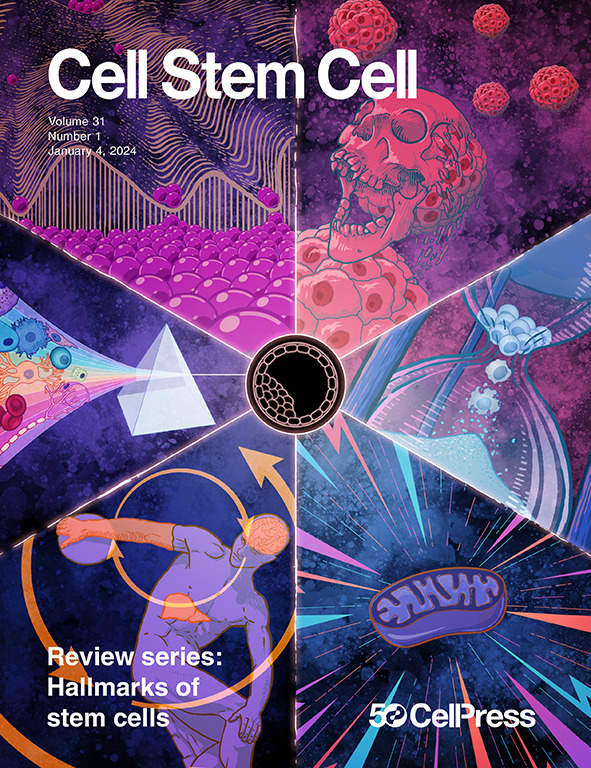利用ipsc衍生的CAR - T细胞克服实体瘤疗效的多重障碍,优先靶向HER2肿瘤
IF 20.4
1区 医学
Q1 CELL & TISSUE ENGINEERING
引用次数: 0
摘要
嵌合抗原受体(CAR) T细胞治疗实体肿瘤受到靶标、非肿瘤毒性、抗原异质性以及无法同时克服肿瘤微环境中多种不同的耐药机制的限制,从而减弱抗肿瘤活性。在这里,我们描述了一种诱导多能干细胞(iPSC)衍生的CAR - T细胞,它结合了人类表皮生长因子受体2 (HER2)靶向CAR - T细胞,与正常细胞区分识别肿瘤,并能够检测截断和错误折叠的HER2,通过多重编辑,旨在解决和克服障碍,最大限度地提高实体肿瘤适应症的疗效。ipsc衍生的HER2定向CAR - T细胞在体外和体内都保持了强大的HER2特异性抗肿瘤活性,对HER2+正常靶标的细胞溶解作用有限。与治疗性抗体的结合,通过CAR和高亲和力、不可切割的CD16a Fc受体,实现了全面的多抗原靶向。此外,白细胞介素(IL)- 7r融合、转化生长因子β (TGF-β)-IL-18R和CXCR2的特异性工程使其持续存在,抵抗TGF-β介导的抑制,并特异性迁移到肿瘤。本文章由计算机程序翻译,如有差异,请以英文原文为准。

Preferential tumor targeting of HER2 by iPSC-derived CAR T cells engineered to overcome multiple barriers to solid tumor efficacy
Chimeric antigen receptor (CAR) T cell therapies in solid tumors have been limited by on-target, off-tumor toxicity, antigen heterogeneity, and an inability to simultaneously overcome multiple diverse resistance mechanisms within the tumor microenvironment that attenuate anti-tumor activity. Here, we describe an induced pluripotent stem cell (iPSC)-derived CAR T cell that combines a human epidermal growth factor receptor 2 (HER2)-targeting CAR—differentially recognizing tumor from normal cells and enabling detection of both truncated and misfolded HER2—with multiplex editing designed to address and overcome obstacles to maximize efficacy in solid tumor indications. The iPSC-derived, HER2-directed CAR T cells maintained potent HER2-specific anti-tumor activity in both in vitro and in vivo settings, with limited cytolytic targeting of HER2+ normal targets. Combination with therapeutic antibodies enabled comprehensive multi-antigen targeting through both the CAR and a high-affinity, non-cleavable CD16a Fc receptor. Additionally, specific engineering of interleukin (IL)-7R-fusion, transforming growth factor β (TGF-β)-IL-18R, and CXCR2 enabled sustained persistence, resistance to TGF-β-mediated suppression, and specific migration to the tumor.
求助全文
通过发布文献求助,成功后即可免费获取论文全文。
去求助
来源期刊

Cell stem cell
生物-细胞生物学
CiteScore
37.10
自引率
2.50%
发文量
151
审稿时长
42 days
期刊介绍:
Cell Stem Cell is a comprehensive journal covering the entire spectrum of stem cell biology. It encompasses various topics, including embryonic stem cells, pluripotency, germline stem cells, tissue-specific stem cells, differentiation, epigenetics, genomics, cancer stem cells, stem cell niches, disease models, nuclear transfer technology, bioengineering, drug discovery, in vivo imaging, therapeutic applications, regenerative medicine, clinical insights, research policies, ethical considerations, and technical innovations. The journal welcomes studies from any model system providing insights into stem cell biology, with a focus on human stem cells. It publishes research reports of significant importance, along with review and analysis articles covering diverse aspects of stem cell research.
 求助内容:
求助内容: 应助结果提醒方式:
应助结果提醒方式:


